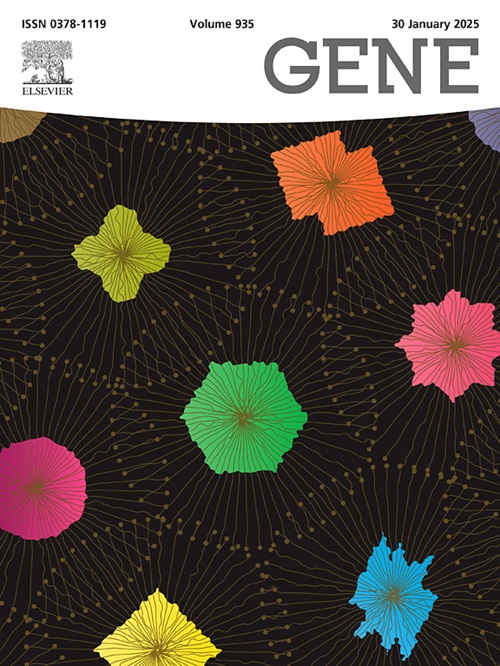Population genetic structure of the fibrinogen-related protein 1 (FREP1) in Iranian isolates of Anopheles stephensi as a promising mosquito-based malaria vaccine candidate
IF 2.6
3区 生物学
Q2 GENETICS & HEREDITY
引用次数: 0
Abstract
Background
Transmission Blocking Vaccines (TBVs) are critical for malaria eradication as they aim to interrupt the transmission cycle of Plasmodium parasites. However, the development of effective TBVs is challenged by the antigenic diversity of potential vaccine targets. This study investigates the fibrinogen-related protein 1 (frep1) gene, a promising candidate for TBVs, focusing on the genetic diversity of the frep1 gene and immunogenic potential in Anopheles stephensi from southern Iran.
Methods
Analysis of 30 An. stephensi isolates collected from three malaria-endemic cities was carried out using molecular amplification, sequencing, and bioinformatics tools. The haplotype and nucleotide diversity were assessed using the DnaSP, while predicted linear B-cell epitopes were evaluated through the ABCpred. Additionally, conformational epitopes were identified via DiscoTope analysis and visualized using the PyMOL. Furthermore, MHC II-peptide interactions were examined to evaluate the potential for effective immune responses.
Results
Seven distinct haplotypes of the frep1 domain were identified, with synonymous nucleotide variations indicating high genetic conservation. This conservation was complemented by the identification of 16 linear B-cell epitopes with high immunogenic scores (0.80–0.97). Conformational epitopes, prominently located at the N-terminus and C-terminus, were consistent across isolates. MHC II-binding analysis revealed peptides with strong affinities to prevalent HLA alleles in Iran, suggesting effective antigen presentation.
Conclusion
FREP1 demonstrates purifying selection, low genetic diversity and high immunogenic potential, highlighting the suitability of the protein as a TBV candidate. The presence of conserved epitopes and strong MHC II interactions supports the potential of this protein for inducing robust immune responses. However, regional haplotype diversity suggests that vaccine strategies may need to account for local variability. These findings underscore the promise of FREP1 for TBV development and emphasize the need for further validation in vivo.

伊朗斯氏按蚊分离株纤维蛋白原相关蛋白1 (FREP1)的群体遗传结构研究
背景:传播阻断疫苗(TBVs)对根除疟疾至关重要,因为它们旨在阻断疟原虫的传播周期。然而,开发有效的tbv受到潜在疫苗靶点抗原多样性的挑战。本研究研究了纤维蛋白原相关蛋白1 (frep1)基因,该基因是TBVs的一个有希望的候选者,重点研究了伊朗南部斯氏按蚊frep1基因的遗传多样性和免疫原性潜力。方法:对30an。利用分子扩增、测序和生物信息学工具对从3个疟疾流行城市采集的斯氏菌分离株进行分析。单倍型和核苷酸多样性通过DnaSP评估,而预测线性b细胞表位通过ABCpred评估。此外,构象表位通过distope分析鉴定,并使用PyMOL可视化。此外,MHC ii -肽相互作用被检查,以评估潜在的有效免疫反应。结果:鉴定了frep1结构域的七个不同的单倍型,具有同义核苷酸变异,表明高度遗传保守性。这种保守性被16个具有高免疫原性评分(0.80-0.97)的线性b细胞表位的鉴定所补充。不同菌株的构象表位是一致的,主要位于n端和c端。MHC ii结合分析显示多肽与伊朗流行的HLA等位基因有很强的亲和力,表明有效的抗原呈递。结论:FREP1具有纯化选择、低遗传多样性和高免疫原性的特点,具有作为TBV候选蛋白的适用性。保守的表位和强MHC II相互作用的存在支持了该蛋白诱导强大免疫反应的潜力。然而,区域单倍型多样性表明,疫苗策略可能需要考虑到当地的差异。这些发现强调了FREP1在TBV发展中的前景,并强调了进一步在体内验证的必要性。
本文章由计算机程序翻译,如有差异,请以英文原文为准。
求助全文
约1分钟内获得全文
求助全文
来源期刊

Gene
生物-遗传学
CiteScore
6.10
自引率
2.90%
发文量
718
审稿时长
42 days
期刊介绍:
Gene publishes papers that focus on the regulation, expression, function and evolution of genes in all biological contexts, including all prokaryotic and eukaryotic organisms, as well as viruses.
 求助内容:
求助内容: 应助结果提醒方式:
应助结果提醒方式:


